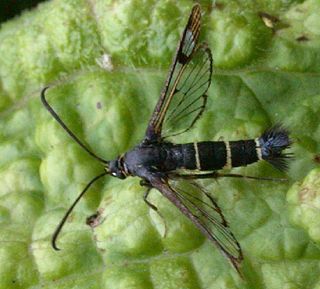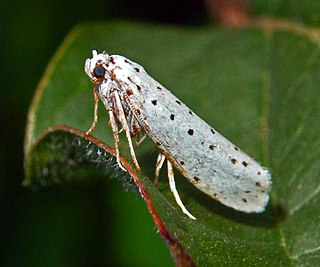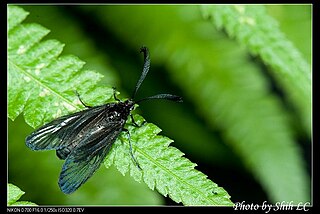
The Sesiidae or clearwing moths are a diurnal moth family in the order Lepidoptera known for their Batesian mimicry in both appearance and behaviour of various Hymenoptera.

Delphacidae is a family of planthoppers containing about 2000 species, distributed worldwide. Delphacids are separated from other "hoppers" by the prominent spur on the tibia of the hindleg.

Asura is a genus of moths in the subfamily Arctiinae, and subtribe Nudariina erected by Francis Walker in 1854.

Dichomeris is a genus of moths in the family Gelechiidae erected by Jacob Hübner in 1818.

Pyrops is a genus of planthoppers that occur primarily in southeast Asia, containing about 70 species. They are fairly large insects, with much of the length due to an elongated, upcurving, snout-like projection of the head. The wings are generally brightly patterned in contrasting colors, and they are popular among collectors.

Platypleura is a genus of cicadas that occurs widely across Africa and southern Asia. Some of the South African species are remarkable for their endothermic thermoregulation that enables crepuscular signalling, an adaptation that reduces risk of predation and enables a greater range for their calls. In field experiments their maximum body temperature while calling at dusk, was measured at 22 °C above ambient temperature.

Lymantria is a genus of tussock moths in the family Erebidae. They are widely distributed throughout Europe, Japan, India, Sri Lanka, Myanmar, Java, and Celebes. The genus was erected by Jacob Hübner in 1819.

Spilosoma is a genus of moths in the family Erebidae originally described by John Curtis in 1825. A very heterogeneous group, it is in need of review by the scientific community, as certain species probably need reclassification into their own genera.

Udea is a genus of snout moths in the subfamily Spilomelinae of the family Crambidae. The genus was erected by Achille Guenée in 1845. The currently known 216 species are present on all continents except Antarctica. About 41 species are native to Hawaii.

Diarsia is a genus of moths of the family Noctuidae.

Arctornis is a genus of tussock moths in the family Erebidae, and the sole member of the tribe Arctornithini. The genus was erected by Ernst Friedrich Germar in 1810.

Ourapteryx is a genus of moths in the family Geometridae. The genus was erected by William Elford Leach in 1814.

Yponomeuta is a large genus of moths of the family Yponomeutidae. It has 103 described member species.

Laphria is a genus described by Johann Wilhelm Meigen in 1803, belonging to the family Asilidae, subfamily Laphriinae. Members of this genus are known as bee-like robber flies. This genus has a Holarctic distribution, occurring in Europe, Asia, and North America. They prey on a variety of insects, including other robber flies, bees, wasps and beetles. Like other asilids, they use their proboscis to penetrate the body of their prey and inject enzymes which dissolve the tissues.

Aphrophora is a genus of spittlebugs in the family Aphrophoridae. There are at least 80 described species in Aphrophora.

Achilidae is a family of planthoppers, sometimes called "achilids" in the order Hemiptera. There are at least 520 described species in Achilidae.

Illiberis is a genus of moths belonging to the family Zygaenidae.

Cosmoscarta is a genus of froghoppers found in the Indo-Malayan region. Many of the species are boldly marked in black and red or yellow. A few species are of economic importance as they can cause injury to plants under cultivation.

Eoscarta is a genus of froghopper (Cercopidae) with about 50 species distributed in the Oriental region. Species in the genus are identified by a combination of characters that include an elongated pubescent body, highly laterally compressed postclypeus, the hind tibia with a single lateral spur and genital characters of the males.


















